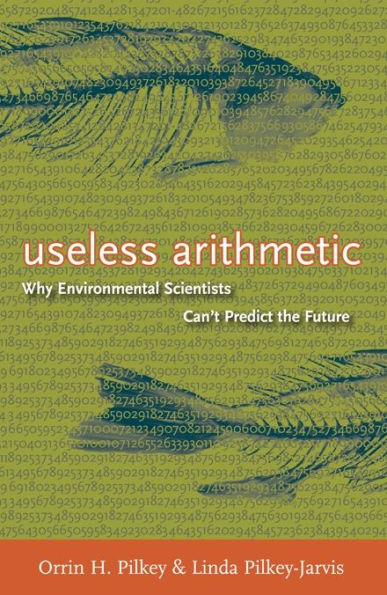Noted coastal geologist Orrin Pilkey and environmental scientist Linda Pilkey-Jarvis show that the quantitative mathematical models policy makers and government administrators use to form environmental policies are seriously flawed. Based on unrealistic and sometimes false assumptions, these models often yield answers that support unwise policies.
Writing for the general, nonmathematician reader and using examples from throughout the environmental sciences, Pilkey and Pilkey-Jarvis show how unquestioned faith in mathematical models can blind us to the hard data and sound judgment of experienced scientific fieldwork. They begin with a riveting account of the extinction of the North Atlantic cod on the Grand Banks of Canada. Next they engage in a general discussion of the limitations of many models across a broad array of crucial environmental subjects.
The book offers fascinating case studies depicting how the seductiveness of quantitative models has led to unmanageable nuclear waste disposal practices, poisoned mining sites, unjustifiable faith in predicted sea level rise rates, bad predictions of future shoreline erosion rates, overoptimistic cost estimates of artificial beaches, and a host of other thorny problems. The authors demonstrate how many modelers have been reckless, employing fudge factors to assure "correct" answers and caring little if their models actually worked.
A timely and urgent book written in an engaging style, Useless Arithmetic evaluates the assumptions behind models, the nature of the field data, and the dialogue between modelers and their "customers."
"1101965484"
Writing for the general, nonmathematician reader and using examples from throughout the environmental sciences, Pilkey and Pilkey-Jarvis show how unquestioned faith in mathematical models can blind us to the hard data and sound judgment of experienced scientific fieldwork. They begin with a riveting account of the extinction of the North Atlantic cod on the Grand Banks of Canada. Next they engage in a general discussion of the limitations of many models across a broad array of crucial environmental subjects.
The book offers fascinating case studies depicting how the seductiveness of quantitative models has led to unmanageable nuclear waste disposal practices, poisoned mining sites, unjustifiable faith in predicted sea level rise rates, bad predictions of future shoreline erosion rates, overoptimistic cost estimates of artificial beaches, and a host of other thorny problems. The authors demonstrate how many modelers have been reckless, employing fudge factors to assure "correct" answers and caring little if their models actually worked.
A timely and urgent book written in an engaging style, Useless Arithmetic evaluates the assumptions behind models, the nature of the field data, and the dialogue between modelers and their "customers."
Useless Arithmetic: Why Environmental Scientists Can't Predict the Future
Noted coastal geologist Orrin Pilkey and environmental scientist Linda Pilkey-Jarvis show that the quantitative mathematical models policy makers and government administrators use to form environmental policies are seriously flawed. Based on unrealistic and sometimes false assumptions, these models often yield answers that support unwise policies.
Writing for the general, nonmathematician reader and using examples from throughout the environmental sciences, Pilkey and Pilkey-Jarvis show how unquestioned faith in mathematical models can blind us to the hard data and sound judgment of experienced scientific fieldwork. They begin with a riveting account of the extinction of the North Atlantic cod on the Grand Banks of Canada. Next they engage in a general discussion of the limitations of many models across a broad array of crucial environmental subjects.
The book offers fascinating case studies depicting how the seductiveness of quantitative models has led to unmanageable nuclear waste disposal practices, poisoned mining sites, unjustifiable faith in predicted sea level rise rates, bad predictions of future shoreline erosion rates, overoptimistic cost estimates of artificial beaches, and a host of other thorny problems. The authors demonstrate how many modelers have been reckless, employing fudge factors to assure "correct" answers and caring little if their models actually worked.
A timely and urgent book written in an engaging style, Useless Arithmetic evaluates the assumptions behind models, the nature of the field data, and the dialogue between modelers and their "customers."
Writing for the general, nonmathematician reader and using examples from throughout the environmental sciences, Pilkey and Pilkey-Jarvis show how unquestioned faith in mathematical models can blind us to the hard data and sound judgment of experienced scientific fieldwork. They begin with a riveting account of the extinction of the North Atlantic cod on the Grand Banks of Canada. Next they engage in a general discussion of the limitations of many models across a broad array of crucial environmental subjects.
The book offers fascinating case studies depicting how the seductiveness of quantitative models has led to unmanageable nuclear waste disposal practices, poisoned mining sites, unjustifiable faith in predicted sea level rise rates, bad predictions of future shoreline erosion rates, overoptimistic cost estimates of artificial beaches, and a host of other thorny problems. The authors demonstrate how many modelers have been reckless, employing fudge factors to assure "correct" answers and caring little if their models actually worked.
A timely and urgent book written in an engaging style, Useless Arithmetic evaluates the assumptions behind models, the nature of the field data, and the dialogue between modelers and their "customers."
30.0
In Stock
5
1

Useless Arithmetic: Why Environmental Scientists Can't Predict the Future
248
Useless Arithmetic: Why Environmental Scientists Can't Predict the Future
248Paperback(New Edition)
$30.00
30.0
In Stock

Product Details
| ISBN-13: | 9780231132138 |
|---|---|
| Publisher: | Columbia University Press |
| Publication date: | 06/29/2009 |
| Edition description: | New Edition |
| Pages: | 248 |
| Product dimensions: | 5.60(w) x 8.70(h) x 0.60(d) |
| Age Range: | 18 Years |
About the Author
What People are Saying About This
From the B&N Reads Blog
